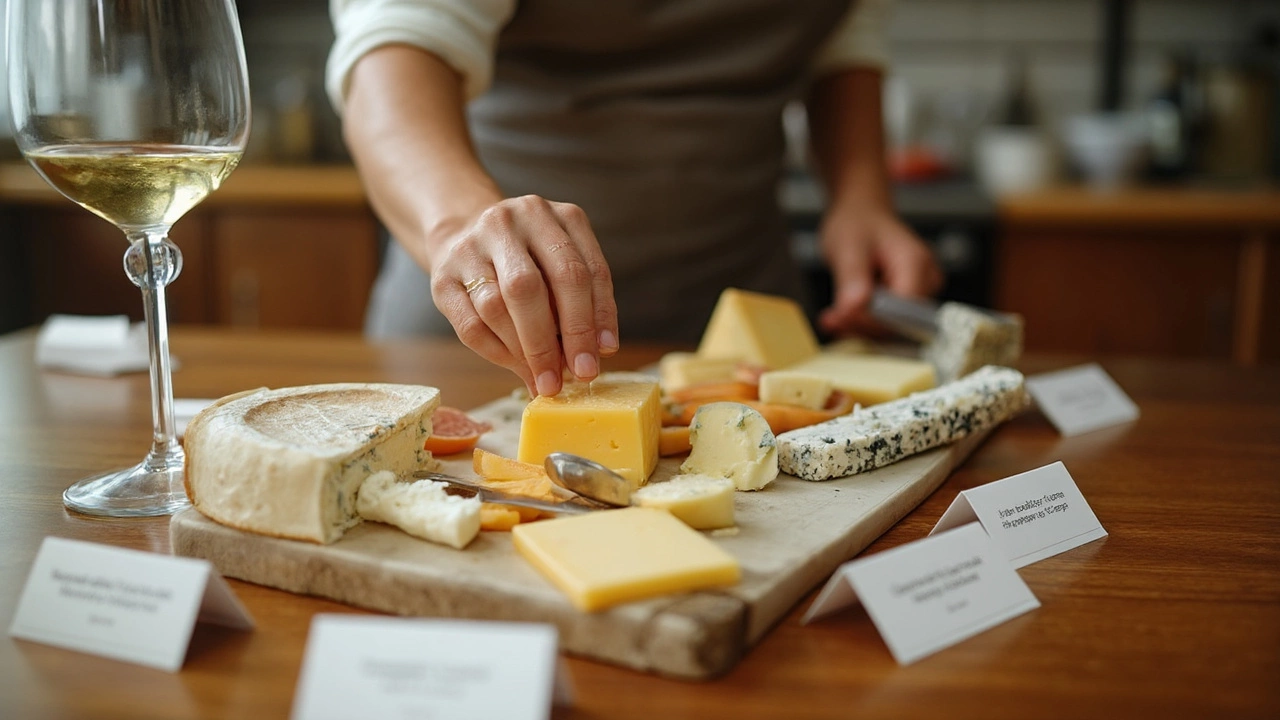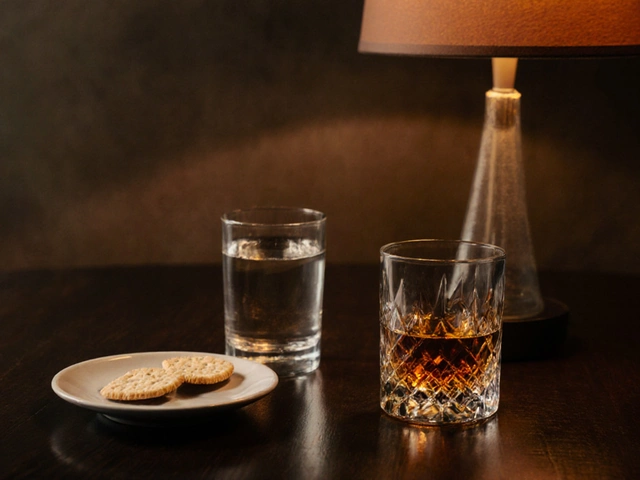Ever had one of those moments where you’ve got a fridge full of cheese and a bunch of white wine, but no clue what goes with what? You’re not the only one. The good news is, white wine is usually easier to pair with cheese than red wine, especially when you’re dealing with those creamy, funky, or tangy options.
Here’s something not everyone realizes: rich, buttery white wines like Chardonnay love soft cheeses—think Brie or Camembert. The combo makes both taste smoother and brighter, not heavy or dull. If you’ve got a block of goat cheese, Sauvignon Blanc is basically a perfect date for it—the citrus kick balances out the creaminess without getting lost in it.
And here’s a tidy trick: bubbles like Prosecco or sparkling wine are cheese MVPs. The fizz cuts through the fat, so even the richest cheeses don’t feel like too much. Grab a glass, slice up some aged Gouda or Swiss, and you’ll see what I mean. No fancy sommelier skills needed—just a little know-how and some experimenting.
- Why White Wine Goes Well with Cheese
- Top White Wines for Classic Cheeses
- Unexpected Pairings That Work
- Tips for Building the Perfect Pairing
- Common Mistakes to Avoid
- Quick Picks for Every Occasion
Why White Wine Goes Well with Cheese
If you think white wine is too light for cheese, here’s what you’re missing: it’s actually the safe bet for most cheese boards. White wine’s crispness cuts through all that cheesy richness so your mouth feels fresh, not overloaded. That punch of acidity is what makes even heavy cheeses feel less, well, heavy.
Let’s get into the details. Most white wines (like Sauvignon Blanc or Riesling) have higher acidity than reds, and that’s a big deal. Acidity acts kind of like a palate cleanser, wiping away the creamy fats between bites. It’s like the difference between eating a grilled cheese with black coffee versus lemonade—one just resets your taste buds better.
Jancis Robinson, one of the world’s top wine experts, said, “For many cheeses, younger and crisper white wines refresh the palate more successfully than tannic reds.”
Another bonus: white wines usually have lower tannins compared to reds. Tannins can react badly with certain cheeses, making things taste oddly metallic or just off. With white wine, you skip that risk.
Here’s a table that shows how popular white wine styles match up with different cheese types:
| White Wine | Cheese Types | Why It Works |
|---|---|---|
| Sauvignon Blanc | Goat cheese, feta | Bright acidity lifts tangy cheeses |
| Chardonnay (oaked) | Brie, Camembert | Buttery notes match creamy textures |
| Riesling (off-dry) | Blue cheese | Slight sweetness tones down salt and funk |
| Prosecco | Aged Gouda, Swiss | Bubbles and acidity cut richness |
So the next time you’re putting together a cheese platter, start with white wines. The flavors pop, nothing clashes, and you can actually taste each cheese’s character. Most wine-and-cheese pros will tell you that’s the whole point.
Top White Wines for Classic Cheeses
Everyone sees the cheese aisle, but which white wine actually goes best with all those favorites? Here’s what you need to know if you want guaranteed crowd-pleasers and combos that actually make sense on your cheese board.
- Sauvignon Blanc and Goat Cheese: For that classic fresh tang, no white wine beats Sauvignon Blanc with goat cheese. The wine’s zippy acidity keeps things refreshing. This combo is huge in France’s Loire Valley and basically sets the bar for easy, tasty pairings.
- Chardonnay and Brie: If you want something smooth, try a creamy Brie with a buttery Chardonnay. If your Brie is extra ripe and gooey, a lightly oaked Chardonnay stops the flavors from getting too intense.
- Riesling and Blue Cheese: This one surprises a lot of beginners. A slightly sweet (off-dry) Riesling balances salty blue cheese in a way that isn’t too funky, just super tasty.
- Pinot Grigio and Asiago: Got a wedge of tangy Asiago? Dry Pinot Grigio brings out the nutty notes without tripping up your tastebuds.
- Moscato and Washed Rind Cheese: Those stinky, creamy cheeses like Taleggio mellow out with the sweetness of Moscato. It’s an easy move if you’re nervous about strong cheeses.
To make pairings even simpler, check out what works best:
| Cheese | White Wine Match | Why It Works |
|---|---|---|
| Goat Cheese | Sauvignon Blanc | Zingy acidity balances creamy tartness |
| Brie | Chardonnay | Buttery meets creamy, never too heavy |
| Blue Cheese | Off-Dry Riesling | Sweetness offsets the saltiness |
| Asiago | Pinot Grigio | Crisp wine cuts through rich flavor |
| Taleggio | Moscato | Sugar dampens funk and cream |
One quick heads up: temperature matters. Pull cheese from the fridge about 45 minutes before serving—flavors explode when they’re not ice cold. Keep your white wine chilled but not freezing; around 45–50°F is the sweet spot for most bottles. Get this right and you’ll look like an absolute pro at your next get-together.
Unexpected Pairings That Work
If you think only the classic stuff works, get ready to be surprised. Sometimes the best combos aren’t the obvious ones—who knew blue cheese could get along with sweet white wine, or that hard cheeses like parmesan would play so well with zippy white blends?
Let’s talk blue cheese first. Gorgonzola or Roquefort with Moscato or even Riesling might sound odd, but the sweet and fruity notes actually mellow out the strong, salty kick of the blue. It’s not just a wild idea—there’s real science behind it. The sweetness balances the salt, and you end up with a way less overpowering bite.
Now, for something even more off-the-wall: try pairing aged cheddar or parmesan with Chenin Blanc. That hint of apple or quince in the wine matches the nutty character of the cheese. It’s not common, but it’s a hit for people looking for less obvious options.
If you like spicy or herby cheeses (like pepper jack or even cheeses rubbed with rosemary), Gewürztraminer is another sleeper match. The touch of sweetness and spice in the wine makes the herbal flavors pop, instead of clashing or getting lost. This is especially handy if your cheese board is heavy on flavors.
Take a look at how some out-there combos rate on the crowd-pleaser scale:
| Cheese | White Wine | Surprise Factor | Crowd Feedback (%) |
|---|---|---|---|
| Blue Cheese | Moscato | High | 87 |
| Aged Parmesan | Chenin Blanc | Medium | 81 |
| Pepper Jack | Gewürztraminer | High | 76 |
| Washed Rind Cheese | Riesling | Medium | 73 |
Not every combo will be for everyone, but these wild cards break up the routine. If you're building a cheese board and feel stuck, throwing in a less typical pairing makes the night a lot more fun. The best part? Some of these surprises end up being new favorites. With a little creativity, white wine really can go with just about anything on your cheese plate.

Tips for Building the Perfect Pairing
Building a great cheese and white wine combo is mostly about balance—matching flavors and textures so nothing overpowers the other. When thinking pairings, start by matching the intensity. Light cheeses wanna hang out with lighter wines, and stronger cheeses can handle something bolder or more complex.
The acid in white wine is your best friend because it cuts through the oils in cheese and keeps things feeling fresh. This is why wines like Sauvignon Blanc or Riesling kill it with tangy cheeses. For richer cheeses, like triple-cream Brie or buttery Camembert, a creamy Chardonnay steps up. Its smoothness doesn't fight the rich flavors—if anything, it makes cheese taste even more special.
Temperature is big, too. Serve white wine a little colder than room temp—around 45-50°F (7-10°C) is a sweet spot. Most cheeses like it between 50-70°F (10-21°C). This way, both the cheese and wine show off their true personalities.
- Fresh tangy cheeses (like goat or feta): Pick crisp wines like Sauvignon Blanc or Pinot Grigio.
- Soft creamy cheeses (think Brie): Go with fuller, oakier Chardonnays.
- Hard cheeses (aged Gouda, Parmesan): Try something with a punch, like a dry Riesling or even a sparkling white.
- Strong, stinky cheeses (washed rind, blue): Try wines with some sweetness, like off-dry Riesling or late harvest whites, because sweet and funky play well together.
Keep it simple—avoid super oaky or high-alcohol whites with delicate cheeses, or the cheese will be lost. If you're ever stuck, grab a bottle of sparkling wine. Bubbles are good with pretty much everything. You won't find many cheese lovers fighting that fact.
Here's a quick cheat sheet with popular pairings for your next cheese board:
| Cheese Type | Example | Best White Wine Pairing |
|---|---|---|
| Fresh | Goat Cheese | Sauvignon Blanc |
| Soft-Ripened | Brie | Chardonnay |
| Semi-Hard | Swiss | Pinot Grigio |
| Hard | Cheddar | Dry Riesling |
| Blue/Vein | Gorgonzola | Off-dry Riesling |
| Washed Rind | Limburger | Sparkling Wine |
Try a few combos until you hit that sweet spot where both flavors seem to get even better. That’s usually when you know you’ve nailed it with your white wine and cheese. And hey, if you mess up, at least you’ve still got wine and cheese on the table—never a bad night!
Common Mistakes to Avoid
It’s pretty easy to mess up wine and cheese pairing, even if you think you’re safe with something like white wine. Most snags happen because people try too hard—or forget some basics.
- Assuming all white wines fit all cheeses: Plenty of folks toss a random bottle on the table, but a sharp blue cheese will totally overpower a lean Pinot Grigio (and vice versa—a bold, oaky Chardonnay can overwhelm fresh mozzarella). Stick to matching intensity. Funky cheese needs more punch; mild cheese goes best with lighter, crisper whites.
- Serving wine and cheese at the wrong temperature: Cold cheese can be bland, and warm wine feels gross. Cheeses should sit out for about 30 minutes before serving, and white wine should be chilled—usually 45-50°F (7-10°C). If you like numbers, the perfect spot in the fridge is the top shelf, away from the back wall.
- Drowning the flavors with extras: Loading the board with spicy meats, strong pickles, or overdoing it with garlic crackers is tempting, but it throws off the balance. Try to keep things simple if you’re new to pairing.
- Ignoring acidity: Cheeses high in fat—like triple cream brie—need wines with good acidity (think Sauvignon Blanc or dry Riesling). If you miss this, everything ends up tasting flat.
- Thinking "aged" means "better": Aged cheeses aren’t always the best call with white wine. Some sharp, hard cheeses taste best with reds or sweeter whites.
Just to give you a quick idea of common pairings people get wrong, check out this table:
| Cheese | Poor Pairing | Why it Fails |
|---|---|---|
| Blue Cheese | Pinot Grigio | Cheese overpowers the wine |
| Fresh Mozzarella | Oaky Chardonnay | Wine tastes heavy, drowns the mild cheese |
| Goat Cheese | Sweet Moscato | Flavors clash, results in weird aftertaste |
Bottom line: chill your wine right, let your cheese breathe, and focus on matches that make sense for both flavor and texture. The best combos usually pop because they make both the wine and cheese taste better together.
Quick Picks for Every Occasion
Sometimes you just want a fast answer when you’re standing in the wine aisle, clueless. So here’s a cheat sheet for when you need to nail that last-minute wine and cheese board, no matter who’s coming over or what’s in your fridge. These matches work because they’re reliable, taste great, and don’t take any weird ingredients or special knowledge.
- White wine for soft cheese night: Grab a bottle of unoaked Chardonnay. It’s creamy but not too buttery, perfect with Brie, Camembert, or triple-creams.
- Sauvignon Blanc for goat cheese or feta. The zippiness cuts right through tangy, salty flavors, making everything pop.
- Pinot Grigio and mozzarella: Super easy and crowd-pleasing. Think pizza, caprese, or just a fresh ball of mozzarella—this match keeps things light and clean.
- Sparkling wine like Prosecco with aged Gouda, Emmental, or even cheddar. The bubbles keep richer cheeses from feeling too heavy.
- Sweet Riesling and blue cheeses like Gorgonzola. The sweetness calms down the sharpness and funk, which is why this combo shows up on so many cheese plates at high-end places.
If you want to see which combos stand out at a party, check out this basic rundown:
| Wine | Cheese | Why It Works |
|---|---|---|
| Chardonnay (unoaked) | Brie, Camembert | Similar creaminess, not overwhelming |
| Sauvignon Blanc | Goat Cheese, Feta | Cuts tang, brightens flavors |
| Prosecco | Aged Gouda, Emmental | Bubbles clear the palate, balance richness |
| Riesling (off-dry) | Blue Cheese | Sweetness tames intensity |
| Pinot Grigio | Mozzarella | Simple, refreshing, crowd favorite |
One tip: Stick to fresh wine if you’re unsure. Most cheeses are better with younger, fruit-forward whites, especially when the flavors aren’t too funky. And don’t overthink it—if you like both the wine and cheese separately, odds are they’ll play nice together.


